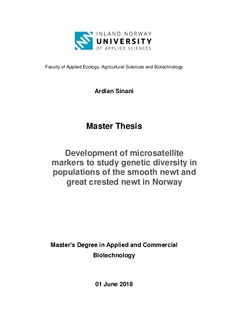Development of microsatellite markers to study genetic diversity in populations of the smooth newt and great crested newt in Norway
Master thesis

Åpne
Permanent lenke
http://hdl.handle.net/11250/2595495Utgivelsesdato
2018Metadata
Vis full innførselSammendrag
The population of amphibians is known to decline in rapid speed and newt species fall in that category. Development of microsatellite markers has the potential to estimate genetic variation in newt populations and investigate the effect of human intrusive, which causes changes to their habitat. The main goal of this study was the development of microsatellite panels for use in both species identification and determination of genetic diversity in populations of smooth newt (Lissotriton vulgaris) and great crested newt (Triturus cristatus) in the southern region of Norway.
Two different strategies were utilized to generate sequences of potential microsatellite loci. The program MPprimer designed primers from already validated microsatellite markers and from sequences identified with GMATo mining tool from publically available genomic sequences. Two primer sets were amplified by a PCR reaction followed by agarose gel electrophoresis. Successfully amplified primers were employed to develop a multiplex PCR with the help of the program Multiplex Manager 1.2. Furthermore, primer pairs with confirmed amplification were tested on singleplex PCR with a three-primer approach. The markers that showed a clear ability for allele calling were grouped and optimized on different multiplex conditions with the help of Applied Biosystems 3130xl Genetic Analyzer accompanied by GeneMapper (v 5.0).
Unfortunately, the number of successfully established markers in this study was low with only six markers showing potential for genotype use. Therefore, we were unable to conduct a genotyping experiment and determine the genetic diversity of newt populations.